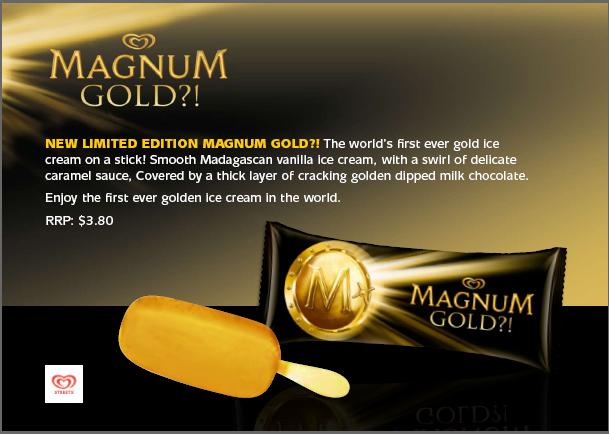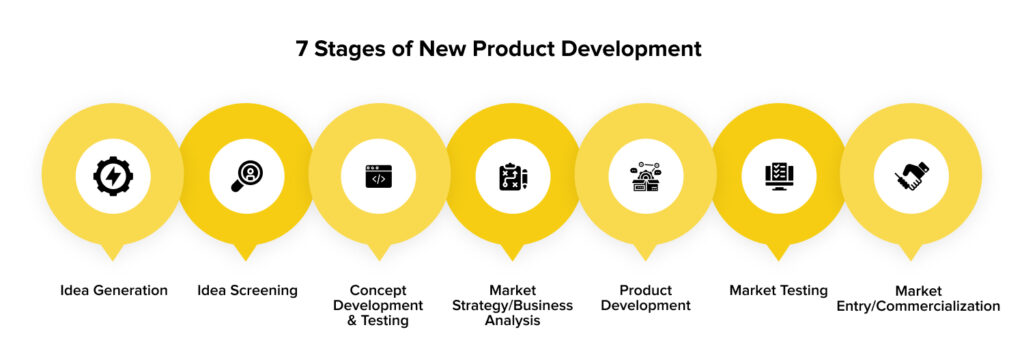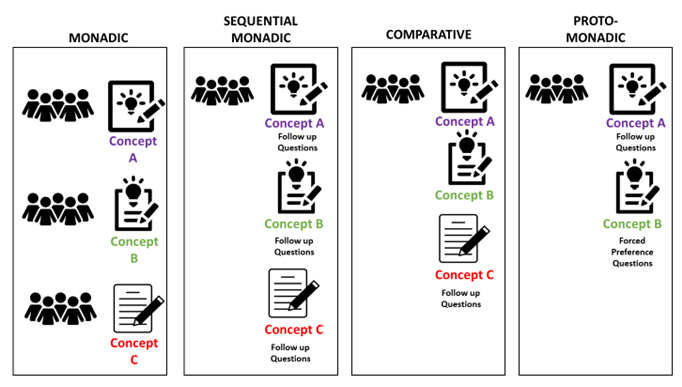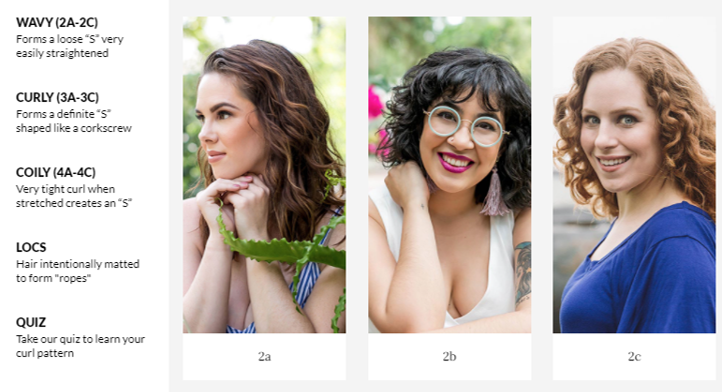The innovation process requires several steps before launch, and one of the most important of them is the Concept Test.
Before developing complex (and expensive!) prototypes and marketing campaigns, you can bullet-proof the idea, testing it with real consumers.
If it scores well on the concept test, then you know it will be able to deliver the business’ requirements, before making huge investments.
First things first… What is a Concept?
What is a Concept?
A concept is a description of an idea in a way consumers will understand.
Concepts can describe entirely new products or services; they can also be small changes to existing things, line extensions or service improvements.
The concept description usually includes its name, purpose, usability, features and benefits; and it can be branded or unbranded – depending on your objectives.
Unbranded concepts are used to test reactions to fundamental elements of the idea.
Branded concepts use the language, design cues and look & feel that could be used in different touchpoints if the concept is launched.

There are several guidelines to concept writing and all of them have pros and cons.
My personal favourite concept format consists in 4 elements:
Insight
Statement relating to the human truth, to which the concept will respond to. If this resonates, the higher the chances of interest from the audience.
It could be implicit within concept, but still needs to be clear and single-minded, so consumers will automatically relate to it.
Benefit
It is the offer, the product or service that you want to sell to consumers. It should explain why consumers should choose this product to respond to the insight’s human truth.
Reason to Believe
This is the differentiation, the reason this product is different from any other available in the market. It exemplifies what makes it better.
Tagline
The summary of the concept in a single line.
Attribution [optional]
Identify the organisation behind it – if you have opted to test a branded concept.
What are Concept Tests for?
There are many usages for Concept Tests in Marketing, Product Development, Digital Transformation, UX etc.
Here are some examples of most common usages of Concept Testing:
In product development:
- Portfolio prioritization.
- Optimize product launch.
- Define most attractive features.
- Determine irrelevant features.
- Understand consumers expectations.
- Adjust idea before prototyping.
- Measure market size and size of the opportunity.
- Evaluate acceptable price.
- Establish competitive environment for new or existing products.
In idea and price relationship:
- Understand features that drive consumers to spend more.
- Identify aspects that are not worth the investment.
In advertising or campaign idea development:
- Understand message potential before developing creative assets.
- Prioritizing campaign ideas.
- Evaluating most appealing claims.
- Understand message comprehension.
- Evaluate brand fit.
In brand relaunch:
- Provide context of alienation of current users.
- Identify opportunity target.
- Understand what generates attraction to new users.
A good example of Concept Testing in identifying opportunity target and relaunching brand is Lego.
After getting complains over being for boys only, the company learned that 90% of their playsets were sold to boys, and girls felt left out. This meaning a huge untapped market opportunity!
They spend 4 years researching 4,500 girls and moms, and testing several concepts to attract girls.
Finally, in 2012, Lego launched Lego Friends, its new line designed for and with girls.
In UX
- Check webpage effectiveness.
- Understand value proposition of landing page.
- Understand useful and necessary information.
- Evaluate different ways of displaying information.
And so many others, such as logo development, packaging improvement etc.
Whatever the reason you are doing a concept test, the business question must be the first definition. From there, the next steps of the research project will be developed.
Sample and questionnaire planning need to be designed with the business issue in focus. However, some specific questions are embedded in most Concept Tests, as they are the keys to highlight winning propositions:
- Overall liking – Overall, How much did you like this idea?
- Likes & Dislikes – What do you like most about it? What you dislike most?
- Purchase Intention – How much do you want to buy it?
- Credibility – How much do you believe in this idea?
- Value for Money – How do you rate the cost of $$$ for this idea?
- Differentiation – How different from other solutions available this new idea is?
What are the benefits in doing a Concept Test?
Concept Testing is the research method that helps assess a concept’s relevance, benefits, differentiation, and pricing before making further investments in its development.
It also helps to prioritise ideas with higher market potential.

In addition, it provides arguments for changes to the idea that will improve acceptance, and even consumers’ willingness to pay more for it.
According to Harvard Business School professor Clayton Christensen, 95% of new products fail because they are designed from inside the companies, for business purposes, instead of putting consumers needs first.
The Concept Test brings consumers to the heart of the business, involving them in decisions which will nurture the launch of effective and successful products.
The main Concept Testing Methodologies
There are 4 types of concept tests. Which one you use will depend on your situation and plans.
Monadic Concept Test:
In a nutshell: Testing a single concept in isolation. Each survey respondent sees only one concept and answers follow up questions about it.
Pros: Serves well for a deep dive into the concept. Helps to understand motivations driving concept’s performance. Helps diagnosis and guide further development.
Cons: Higher sample, higher costs.
Sequential Monadic Concept Test:
In a nutshell: Each respondent evaluates 2 or more concepts, with the same follow up questions after each one.
Pros: Less sample required, hence faster fieldwork. Good for tiebraking, as consumers choose the best performer in comparison.
Cons: It is more biased, questionnaire could be too long, making fieldwork challenging, with many drop outs.
Comparative Concept Test:
In a nutshell: Respondents see all concepts before choosing the best one, with very little to none follow up questions.
Pros: Provides a high level winner concept, with fast fieldwork.
Cons: Lacks further diagnosis and context, might need further research to guide concept changes.
Proto-Monadic Concept Testing:
In a nutshell: It is a combination of sequential monadic and comparative approaches. Each respondent evaluates 2 concepts: first one with follow up questions about it. And for the second, only preference is asked (via preference question or/and attributes).
Pros: It is used to check if the overall preference can be explained with insights captured in the first concept. It serves well for further diagnosis, when you need to compare ideas.
Cons: Requires larger sample for each concept’s depth diagnosis.
The diagram below illustrates the main characteristics of Concept Test methodologies:

How to analyse Concept Test results
Very often, the key question asked is “is the concept score high enough?”
High enough to progress to the next stage, to justify more investment, or even to start manufacture and launch planning. ‘High enough’ is measured against internal benchmarks, other concept tests or a set of competitive products.
In order to evaluate if results are really a win or just a better option among the worst, it is important to understand what success looks like. Standalone results such as 65% purchase intention mean very little if you do not know the market and consumers.
There are ways to analyse the data that provide perspective to Concept Test:
Database
Some research agencies combine all tests into a huge database (if they follow identical protocols) and you can see the results of your test within the context of the market or category. You cannot see other companies’ results, but it is possible to place the tested concept amongst the top, average and bottom performers.
Benchmark
You can add another concept to the test, which will be the benchmark to leverage results. The action standard will evaluate whether the new tested concept is a go/no go comparatively to reference results.

BUMO (Brand Used Most Often) or MOPP (Most Often Purchased Product)
The respondent places the concept within their imaginary competitors set, comparing it to the Brand/Product they use more frequently. And the Concept Test is based in the comparison between current usage and new proposition.
Ipsos uses this approach and compares index to Innovation database to define what is good enough.

What are the risks in running Concept Tests?
The biggest watch out for concept testing is when testing ground-breaking innovation or niche products.
Consumers can easily describe their current problems, but they are not able to think about a solution for it, outside of their universe.
Therefore, when testing disruptive or too targetted concepts, the simpler, the better. Consumers need to understand the proposition clearly or they simply reject it. In addition, the financial potential of the initiative must take into consideration that only early adopters will buy it, in the first year of launch.
To illustrate this, there is a famous Henry Ford quote about consumers’ repertoire: “If I had asked people what they wanted, they would have said faster horses.” We all know the end of this story… that is how cars came up!
Some ideas are simply not for everyone, and concept testing them can give the false impression of failure.
For example, only 11% of world’s population has curly hair. However, according to Naturally Curly they spend $247 per year in hair products – 78% more than the straight haired.
So, if we are testing a concept for curls, its purchase intention would hardly be higher than 11% – hence, failure. But knowing curly haired consumers behaviour and expenditure, there is a niche opportunity that could make sense. It could be the case to test only with curly hair consumers, for example – knowing they would not be representative of whole population.

Tips for successful Concept Tests
Establish what does success look like
Before choosing the methodology, decide what are the critical facts that determine whether the idea is worth moving on with – it could be performance against a benchmark, or specific consumer group, or price acceptance. This information will determine methodology and areas of approach.
Compare
Even though you have a great and bullet proof idea that surely will succeed, do not test it without having comparative results to establish likelihood to succeed. Could be via database, benchmark, most often used etc. Always place it into context.
Differentiate
Make sure the ideas in the same test are really different. Small changes can be tricky for consumers to differentiate – for example, changing only one word or sentence, or including one feature in the exact same concept. Make sure differences can be noticed and not be part of one big blur.
Prioritize
Avoid stuffing as many concepts as possible within the same test – instead of optimizing costs, you will end up stressing the sample, skipping specific targeting and being superficial.
Adjust
Underperforming in a concept test is not necessarily a no go for the idea. Very often, adjusting unique selling proposition, target, description, and context could bring it back to the game.
K.I.S.S. (Keep it simple, stupid)
Do not measure respondents by your standards, you know absolutely everything about this idea, whereas consumers do not even think about why they purchase it. Keep it simple, clear, and single minded and do not prompt or guide responses.
Broaden
Watch out for strict samples – sometimes you miss opportunities to expand product reach to audiences you did not consider. Or even overestimate market potential.
Plan statistics ahead
Before going into field, plan all the statistical analysis you might need as they are bound to sample size, randomization, and profile. For example, if you need statistical significance against a specific subgroup, you need to guarantee this subgroup has been equally distributed and has sufficient sample size.


This is great – thank you